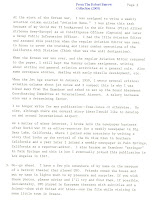




Tom Towers probably wasn't too difficult to find in the seventies, if you lived in California. But I was in New York, clueless except for the knowledge that he had written for The Los Angeles Examiner, so imagine my surprise and disappointment when I discovered The Examiner had folded years ago. My first hint to that effect arrived in the mail when my letter of inquiry to the newspaper was returned as undeliverable.
However, when Al Chop managed to sit down at the typewriter and pound out a lengthy response to my questions, he mentioned that, last he heard, Towers was working for the Department of Airports in L.A. Hoping for the best but expecting nothing, I mailed off a brief note to L.A. and enclosed the customary self-stamped, addressed envelope, a necessity that often makes the difference between getting a response and being ignored. In the meantime, at least I was happy to have located Dewey Fournet, for Chop had lost track of Fournet long ago and appreciated knowing of his current address in Louisiana.
As November of 1975 prepared for surrender to December and the country's preoccupation with the Christmas season and holiday slowdowns in the workplace, I felt almost certain that Towers had more important things to do than reply to somebody who claimed to be a writer in search of information on a now relatively obscure motion picture. Imagine my amazement, then, when my self-stamped envelope arrived with a Los Angeles postmark, and there was something small inside -- a business card (see). "The lost has been found," L.A. Dept. of Airports executive assistant Tom Towers assures me. He had certainly experienced quite a job change since those days as a reporter and columnist for The Los Angeles Examiner.
Thrilled though I was to get a response, I feared an uncertain correspondence relationship with Towers. After all, if the best he could do was send along a business card with a few autobiographical words scribbled on it, what could I expect in attempting to get some in-depth answers from him? Not to worry. As it turned out, Tom Towers ended up writing me more than any of the other "U.F.O." participants, even after the article saw publication, and he gracefully and candidly answered every question I addressed.
We'll explore Tom's correspondence in weeks to come, but today I wanted to post a few photos in way of introduction. One black-and-white publicity photo depicts a typical pose for Towers as he sits at the Air Force press desk in his role as Al Chop. The other b&w picture portrays Chop (Towers) and his wife (played by actress Marie Kenna) in a dramatic moment as a phone call alerts them to the return of UFOs over Washington, D.C. for the second time in a week. This scene leads up to the dramatic climax of the movie as UFOs are tracked by radar and seen visually high over the nation's Capitol in 1952.
The two small color snapshots of Tom Towers on the tennis court actually were sent on the spur of the moment because I really pressed him for photos and those were the most convenient for him. They aren't very clear and I wasn't really looking for the athletic pose (!), and they never did run with any of my articles about the movie, but I'm pleased to include them here. Tom seemed most at home on the tennis court, on the golf course or on a bowling excursion with friends. These pictures were taken approximately 20 years after Tom's performance in "U.F.O." He never acted in another movie -- but could have. More on that later.
Recently, a mysterious somebody updated information on Tom Towers for the imdb.com Web site and I wish I knew that person's identity, for I never knew much about Towers' personal life. I was surprised, frankly, to find additional imdb information because I had originally added a blurb about Towers to his otherwise vacant movie celebrity page and never dreamed anybody was out there to add, or care to add, what seemed some out of the ordinary updates. I really suspect a family member provided this kindness in memory of Tom, who, from all accounts, was a wonderful and charming man who cared about his work, the people who knew him and the environment (in terms specifically of jet aircraft noise).
Researcher Barry Greenwood, co-author of Clear Intent, one of my favorite books of all time about UFOs, offered more information about Towers a few weeks ago, and imparted data confirming that Thomas H. Towers was born in 1913 in Kentucky and died in L.A. in 1995 at age 82. The updated imdb site related that Towers was 6'1" in height and had enlisted in the U.S. Army Air Corps at the Santa Ana Army base on December 14, 1942. Towers had already told me that he was a captain working in military intelligence during World War II.





.jpg)















































